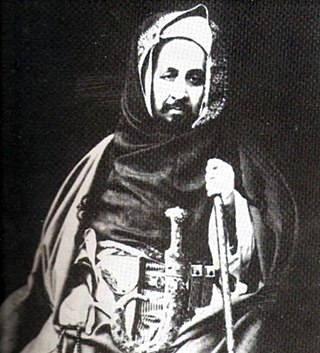
Mohieddin Fikini, last name also spelled Fekini, was the Prime Minister of Libya from 19 March 1963 to 22 January 1964. He was also the Minister of foreign affairs from 19 March 1963 to 22 January 1964.

The Senussi campaign took place in North Africa from November 1915 to February 1917, during the First World War. The campaign was fought by the Kingdom of Italy and the British Empire against the Senussi, a religious order of Arabic nomads in Libya and Egypt. The Senussi were courted by the Ottoman Empire and the German Empire. In the summer of 1915, the Ottomans persuaded the Grand Senussi Ahmed Sharif as-Senussi to declare jihad, attack British-occupied Egypt from the west and to encourage insurrection in Egypt to divert British forces.

Gazala, or ʿAyn al-Ġazāla, is a small Libyan village near the coast in the northeastern portion of the country. It is located 60 kilometres (37 mi) west of Tobruk.

Ramadan Sewehli, also spelt as Ramadan al-Suwayhili, was a prominent Tripolitanian nationalist at the outset of the Italian occupation in 1911 and one of the founders of the Tripolitanian Republic.

Italian Tripolitania was an Italian colony, located in present-day western Libya, that existed from 1911 to 1934. It was part of the territory conquered from the Ottoman Empire after the Italo-Turkish War in 1911. Italian Tripolitania included the western northern half of Libya, with Tripoli as its main city. In 1934, it was unified with Italian Cyrenaica in the colony of Italian Libya. In 1939, Tripolitania was considered a part of the Kingdom of Italy's 4th Shore.

Italian Cyrenaica was an Italian colony, located in present-day eastern Libya, that existed from 1911 to 1934. It was part of the territory conquered from the Ottoman Empire during the Italo-Turkish War of 1911, alongside Italian Tripolitania.

The Libyan resistance movement was the rebel force opposing the Italian Empire during its Pacification of Libya between 1923 and 1932.
Zawiat at-Taban, or Taban ; also An-Nayan or Wadi Sammalus, is a check point in the District of Jabal al Akhdar in north-eastern Libya. It is located on the cross-roads between the Charruba–Mechili–Timimi desert road and the Marawa–Wadi Sammalus.

Conflicts took place in North Africa during World War I (1914–1918) between the Central Powers and the Entente and its allies. The Senussi of Libya sided with the Ottoman Empire and the German Empire against the British Empire and the Kingdom of Italy. On 14 November 1914, the Ottoman Sultan proclaimed a jihad and sought to create a diversion to draw British troops from the Sinai and Palestine Campaign. Italy wished to preserve its gains from the Italo-Turkish War. The Senussi Campaign took place in North Africa from 23 November 1915 to February 1917.

Sharif El Gariani (1877–1945) was a Libyan religious sheikh and statesman.

The Libyan People's Court is an emergency tribunal founded in Libya after the revolution of 1 September 1969. Although its initial purpose was to try the officials of the overthrown Kingdom, many others also were tried by this court. This article discusses only the trial of officials of the Kingdom.

Ahmed Sharif as-Senussi was the supreme leader of the Senussi order (1902–1933), although his leadership in the years 1917–1933 could be considered nominal. His daughter, Fatimah el-Sharif was the Queen consort of King Idris I of Libya.

The 15th Ludhiana Sikhs was an infantry regiment in the British Indian Army. They could trace their origins to 1846, when they were known as the Regiment of Ludhiana. During the Indian Mutiny they were relied upon to hold Benares throughout the period of the Mutiny. In 1861, they became the 15th Bengal Native Infantry and shortly afterwards to the 15th (Ludhiana) Regiment of Bengal Native Infantry in 1864. Further changes in title followed they became the 15th Regiment of Bengal Native Infantry in 1885, the 15th (Ludhiana) Sikh Infantry in 1901 and the 15th Ludhiana Sikhs following the Kitchener reforms of the Indian Army in 1903. To honour the visit of the Prince and Princess of Wales to Indian they took part in the Rawalpindi Parade 1905.

The Action of Agagia took place east of Sidi Barrani in Egypt on 26 February 1916, during the Senussi Campaign between German and Ottoman-instigated Senussi forces and the British army in Egypt. On 11 December 1915, a British column had been attacked at Duwwar Hussein along the Matruh–Sollum track. In the Affair of Wadi Senba, the Senussi were defeated and two days later a Senussi attack at Wadi Hasheifiat was repulsed. The British returned to Matruh until 25 December, then surprised the Senussi at the Affair of Wadi Majid but the Senussi got away. At the Affair of Halazin on 23 January, the Senussi were defeated and again slipped away.

The Second Italo-Senussi War, also referred to as the Pacification of Libya, was a conflict that occurred during the Italian colonization of Libya between Italian military forces and indigenous rebels associated with the Senussi Order. The war lasted from 1923 until 1932, when the principal Senussi leader, Omar al-Mukhtar, was captured and executed.
The Battle of Gasr Bu Hadi occurred during the Italian colonization of Libya. It was the worst Italian defeat since the Battle of Adwa.
The Battle of Al-Rahiba was a military engagement between the Senussi order led by Omar al-Mukhtar and the Italians. The Senussi won a resounding victory against the Italians.
The Battle of Bir Tabraz was fought in December 1911 during the Italo-Turkish War between the Kingdom of Italy and Senussi forces in a place near Tripoli in modern Libya, the Senussi successfully forced to Italians to withdraw.
The Battle of Safsaf was fought in July 1913 between the Kingdom of Italy and Senussi forces in a place near Safsaf, Libya in modern Libya. The Senussi succeeded in defeating two Italian forces.
The Battle of Bir Bilal was a military engagement between the Senussi order and the Italians. The Senussi won a resounding victory against the Italians.












